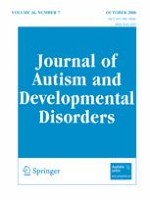01-10-2006 | Original paper
Comorbid Psychiatric Disorders in Children with Autism: Interview Development and Rates of Disorders
Gepubliceerd in: Journal of Autism and Developmental Disorders | Uitgave 7/2006
Log in om toegang te krijgenAbstract
The Kiddie Schedule for Affective Disorders and Schizophrenia was modified for use in children and adolescents with autism by developing additional screening questions and coding options that reflect the presentation of psychiatric disorders in autism spectrum disorders. The modified instrument, the Autism Comorbidity Interview-Present and Lifetime Version (ACI-PL), was piloted and frequently diagnosed disorders, depression, ADHD, and OCD, were tested for reliability and validity. The ACI-PL provides reliable DSM diagnoses that are valid based on clinical psychiatric diagnosis and treatment history. The sample demonstrated a high prevalence of specific phobia, obsessive compulsive disorder, and ADHD. The rates of psychiatric disorder in autism are high and are associated with functional impairment.
